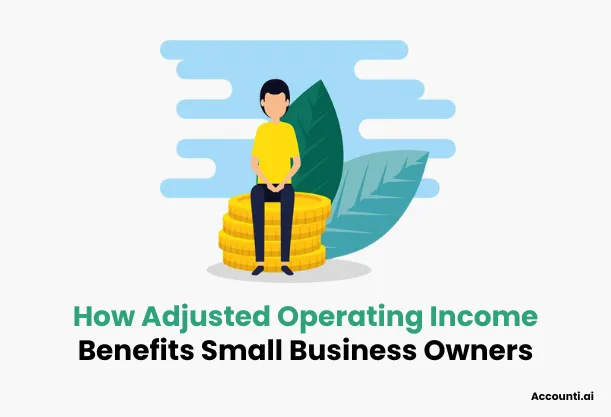
How Adjusted Operating Income Helps Small Business Owners
Running a small business can feel like navigating a maze. Amid the chaos of invoices, expenses, and profits, understanding your business's financial health is crucial. This is where Adjusted Operating Income (AOI) comes into play. It’s not just a buzzword; it’s a financial metric that can be a game-changer for small business owners.
In this article, we’ll dive deep into AOI, its calculation, benefits, and why every small business owner should have it in their toolkit. Let’s uncover how it helps you make smarter financial decisions and steer your business toward sustainable growth.
What is Adjusted Operating Income?
Adjusted Operating Income is the net income from a company’s operations, adjusted to exclude irregular, non-recurring, or non-operational costs. It provides a clearer picture of the company’s core profitability, ignoring external noise like one-time expenses, legal settlements, or restructuring costs.
Components of AOI
AOI typically includes:
- Revenue: Total income generated by your business operations.
- Operational Costs: Regular expenses incurred to run the business, like salaries, rent, and utilities.
- Adjustments: One-time costs (e.g., lawsuits, asset write-offs) or non-operational income (e.g., investments).
How is it Different from Operating Income?
While operating income focuses on revenue minus all operational expenses, AOI refines this calculation by removing anomalies. Think of it as polishing a gem—it’s the true reflection of your business’s core profitability.
Why Adjusted Operating Income Matters for Small Business Owners
If you’re a small business owner, you’re wearing multiple hats—CEO, accountant, and sometimes even janitor. Understanding AOI can simplify your financial planning in several ways.
1. Clarity on Core Business Performance
AOI strips away distractions to reveal the heart of your business’s performance. By excluding one-off events, it ensures you’re not misled by temporary gains or losses.
For instance, a one-time legal settlement might skew your profits. AOI allows you to exclude that and focus on what’s truly happening in your operations.
2. Strategic Decision-Making
Data-driven decisions are always better. AOI helps you:
- Identify profitable products/services
- Cut unnecessary costs
- Allocate resources efficiently
3. Attracting Investors and Securing Loans
Investors and lenders want transparency. AOI provides a clean snapshot of your business’s financial health, increasing your chances of securing funding.
How to Calculate Adjusted Operating Income
Now that we understand its importance, let’s see how to calculate it.
Step-by-Step Guide
- Start with Operating Income:
- Subtract operational expenses from your revenue.
- Add Back Non-Cash Expenses:
- Include items like depreciation and amortization.
- Exclude Non-Operational Costs:
- Remove expenses such as legal fees, restructuring costs, and one-time charges.
Example Calculation
Let’s consider a small café owner:
|
Description |
Amount ($) |
|
Revenue |
150,000 |
|
Operating Costs |
100,000 |
|
Operating Income |
50,000 |
|
One-Time Legal Settlement |
10,000 |
|
Depreciation Expense Added |
5,000 |
|
Adjusted Operating Income |
45,000 |
Common Adjustments
- Depreciation/Amortization (non-cash costs)
- Restructuring Costs (temporary)
- One-Time Expenses (not recurring)
Key Benefits of Adjusted Operating Income for Small Businesses
AOI isn’t just another number—it’s a powerful tool. Here’s how it benefits small businesses:
1. Identifying Profitability Trends
Tracking AOI over time helps you:
- Recognize seasonal trends
- Spot declining or improving profit margins
2. Better Budgeting and Financial Planning
AOI simplifies budgeting by focusing on sustainable income. It helps you forecast future growth without being misled by one-off gains or losses.
3. Improved Credibility with Stakeholders
Be it banks, investors, or partners—transparency in your finances builds trust. AOI ensures your financial reports are accurate and reliable.
Common Challenges and How to Overcome Them
Despite its advantages, calculating AOI has its challenges. Let’s address them.
1. Mistakes in Adjustments
Incorrectly identifying non-recurring costs can lead to flawed AOI
calculations.
Solution: Work with a professional accountant or
use automated tools.
2. Lack of Accurate Data
Without proper record-keeping, calculating AOI is
impossible.
Solution: Maintain organized financial records and
invest in accounting software.
3. Time Constraints
Small business owners often don’t have time for detailed
calculations.
Solution: Automate processes with tools like
QuickBooks or Xero.
Real-Life Applications of Adjusted Operating Income
Let’s explore how small business owners can leverage AOI in practical scenarios.
Scenario 1: Evaluating a New Location
Imagine you’re opening a second store. AOI helps you:
- Determine if your current profits can sustain expansion.
- Estimate how much revenue you need to break even.
Scenario 2: Preparing for Investors
You’re pitching to investors for funding. By presenting AOI, you:
- Showcase your core profitability.
- Build credibility with transparent financial data.
Scenario 3: Cutting Costs
Your AOI trends show declining profitability. You can:
- Identify unnecessary expenses.
- Reallocate resources to more profitable areas.
Conclusion
In the fast-paced world of small business, clarity is king. Adjusted Operating Income acts like a financial compass, guiding you through complexities and helping you focus on what truly matters. It simplifies decision-making, builds trust with stakeholders, and ensures long-term sustainability.
If you’re not already tracking AOI, it’s time to start. Think of it as a secret weapon to stay ahead in the competitive business landscape.
FAQs
How do you calculate adjusted operating income?
Adjusted Operating Income (AOI) is calculated by taking the company's operating income and making specific adjustments to exclude non-recurring, non-operational, or non-cash items. This provides a clearer picture of the company's core operational profitability. The formula is:
Adjusted Operating Income = Operating Income + Non-Recurring Expenses - Non-Recurring Income + Non-Cash Expenses
Steps to Calculate AOI:
- Determine Operating Income: Subtract operating expenses from gross profit.
- Add Back Non-Recurring Expenses: Include one-time costs like restructuring charges.
- Subtract Non-Recurring Income: Exclude one-time gains such as asset sales.
- Add Non-Cash Expenses: Incorporate non-cash items like depreciation and amortization.
By adjusting for these items, AOI reflects the profitability from regular business operations, excluding anomalies.
What is the difference between net income and adjusted operating income?
Net income is the company's total profit after all expenses, including operating costs, interest, taxes, and non-operating items, have been deducted from total revenue. It represents the "bottom line" of the income statement.
Adjusted Operating Income, on the other hand, focuses solely on the profitability from core business operations. It excludes non-recurring, non-operational, and non-cash items to provide insight into the company's operational efficiency.
Key Differences:
- Scope: Net income includes all revenues and expenses, while AOI focuses only on operational aspects.
- Adjustments: AOI adjusts for one-time and non-operational items; net income does not.
- Purpose: Net income shows overall profitability; AOI assesses core operational performance.
Understanding both metrics is crucial for a comprehensive financial analysis.
Is adjusted operating income the same as EBITDA?
No, Adjusted Operating Income (AOI) and Earnings Before Interest, Taxes, Depreciation, and Amortization (EBITDA) are distinct metrics, though they both assess a company's operational performance.
Adjusted Operating Income:
- Focuses on core operational profitability.
- Excludes non-recurring, non-operational, and non-cash items.
EBITDA:
- Measures earnings before interest, taxes, depreciation, and amortization.
- Adds back non-cash expenses like depreciation and amortization to operating income.
Key Differences:
- Adjustments: AOI excludes specific items to reflect core operations; EBITDA adds back certain expenses to show cash flow potential.
- Purpose: AOI provides insight into operational efficiency; EBITDA indicates cash flow generation capability.
Both metrics offer valuable perspectives but serve different analytical purposes.
Is operating income the same as gross profit?
No, operating income and gross profit are different financial metrics, each highlighting distinct aspects of a company's profitability.
Gross Profit:
- Calculated as revenue minus the cost of goods sold (COGS).
- Reflects the profit earned from producing goods or services before deducting operating expenses.
Operating Income:
- Calculated as gross profit minus operating expenses (e.g., selling, general, and administrative expenses).
- Indicates the profit from core business operations after accounting for all operating costs.
Key Differences:
- Scope of Expenses: Gross profit considers only direct production costs; operating income includes all operating expenses.
- Profitability Insight: Gross profit assesses production efficiency; operating income evaluates overall operational profitability.
Understanding both metrics is essential for analyzing different profitability stages.
Which is not considered an operating income?
Operating income includes revenues generated from a company's primary business activities. However, certain revenues are classified as non-operating income because they arise from activities outside the company's core operations. Examples include:
- Interest Income: Earnings from investments or savings.
- Dividend Income: Profits received from investments in other companies.
- Gains from Asset Sales: Profits from selling assets not related to regular business activities.
- Foreign Exchange Gains: Profits from currency exchange rate fluctuations.
These items are excluded from operating income to provide a clear view of earnings from primary business operations.
By distinguishing between operating and non-operating income, stakeholders can better assess a company's operational performance.

 Rohit Kapoor
Rohit Kapoor

